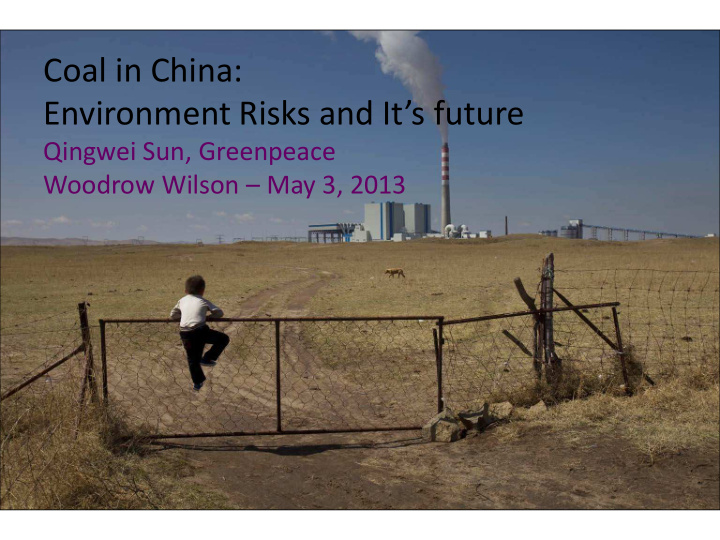



Coal in China: Environment Risks and It’s future Qingwei Sun, Greenpeace Woodrow Wilson – May 3, 2013
• China coal industry overview • Thirsty coal • Air pollution • CO 2 emissions • Policy dynamics • Coal imports
China Coal Industry History 1978: 620 million tons 2012: 3.62 billion tons Coal mines (Fragmented): • Key SOE Mines • Local SOE Mines • Private (TVE) Mines
1978 1997 Early 2000s: 抓大放小 policy: Restore 104 Key SOE Beijing forced to allow surge profitability of SOEs in private supply due to lack + 2000 Local SOE: 85% of supply growth to meet of production Ministry of Coal Industry demand. Abolished 15%: TVE Mines Mining deaths forces another Key SOEs put under wave of consolidation provincial management 1983 2009: Shanxi consolidation Beijing endorses +s: Reduced coal mines, -Mines fell from (2,600 to private mines safety improved, 1,100) profitability restored -Key SOE share increased to 1982 – 1996: 50% TVE mine production -s: Coal statistics became grows from 100m to highly unreliable Consolidation extended now 700m tons to: Rise of underground small (Country total doubles mines -Inner Mongolia over this period) Supply growth slowed -Henan -Guizhou -Shandong
China’s Coal Addiction China = world’s largest coal producer, user, and biggest emitter of CO 2 2011: half of global coal production (BP); consumption reached 3.52 billion tons Total CO2 emission over 9 Giga Tons by 2011 (BP); per capita levels in 2011 are getting close to average of European levels (7.2t vs. 7.5t) Over reliance on coal, nearly 70% of primary energy use; 80% in power generation Non fossil fuel 8.1% in primary energy use in 2011
Coal Bases
Why coal bases • The Central Government: More energy to sustain economy development • Coal enterprises: Unlimited coal • Local governments: Yes, more coal, but more money to my pocket • A “win-win-win”: coal bases with a longer coal industry chain (coal mine, coal power, coal chemicals)
Coal and water conflict
Water Disconnect New Coal Power Bases: 14 large-scale coal power bases with a total expected installed capacity of 600GW, will be built, predominantly in driest part of country. Expected Coal Power Base Water Consumption: 9.975 billion m3 of water in 2015 Water Situation in the West: 2015 coal power base demand for water > Provinces' respective 2010 water consumption. Expected Yellow River Pollution: 5 coal power bases currently located along the Yellow River discharge more 80 million tons of waste annually, which ultimately flows into the river stream.
Financial Community “China plans to add more than the total installed power capacity of the US, the UK and Australia by 2030. Consequently, industry faces more water and electricity shortages Project financiers, investors and companies should consider resource shortages and more efficient options before funding, investing and expanding.” HSBC Global Research, Sept 2012
Air pollution 2013 twin conference. 3 blue sky during 14 days
Source contributions to PM2.5 in Beijing Dust and others, 28% Coal, 39% Biomass, 12% Transport, 9% Industry, 12% National Wide Coal contributes: SO2 75% NO2 85% NO 60% TSP 75%
CO 2 emission
Environment & Resource Constraints / Choke Points for unlimited growth of coal Carbon Emission Water Resource Air Pollution
Environmental and Ecologic Losses from Coal Use and Exploitation Equivalent to 7-9% of Annual GDP
Policy dynamics • Coal production and consumption revolution • Accelerating coal bases development • Systematically promote the shift of coal resource from a type of fuel to raw material (coal to gas, coal to oil, coal chemicals (olefin, etc.)
Is the future going to be greener?
A coal cap?
Key Highlights 2 announced “allocated” caps: • Primary energy consumption cap: – 4 billion metric tons of coal equivalent by 2015 • Total Power use cap: – 6.15 trillion kilowatt-hours in 2015 Repeat of previous targets: 2015 carbon intensity target: 16% drop from 2010 2015 energy intensity target: 17% drop from 2010 2020 carbon intensity target: 40 – 45% from 2005 levels
for 13 th FYP : energy cap, but not coal cap
Breakthrough with distributed Solar PV?
Coal import
Surging coal imports China’s coal imports surged in 2009-2010, mainly due to rising domestic coal price. But imported coal is less than 5% of China’s total coal consumption in 2010. 2013 coal import: 290 Mt
Outlook • More in-depth research coal-environment conflict, particularly, coal-water nexus and air pollution, by government departments, financial communities, NGOs and academia circle • Major coal policy adjustment in 13 th FYP • Energy cap, no coal cap • Coal import sees great uncertainty in long term.
Thank you qsun@greenpeace.org
Water grab • Overexploit ground water • Pump surface water • Build dams • Water diverting
Damages • Ground water level decrease, vegetation die, and land degradation • Water pollution • Disadvantage groups exploited • Social instability
Recommend
More recommend